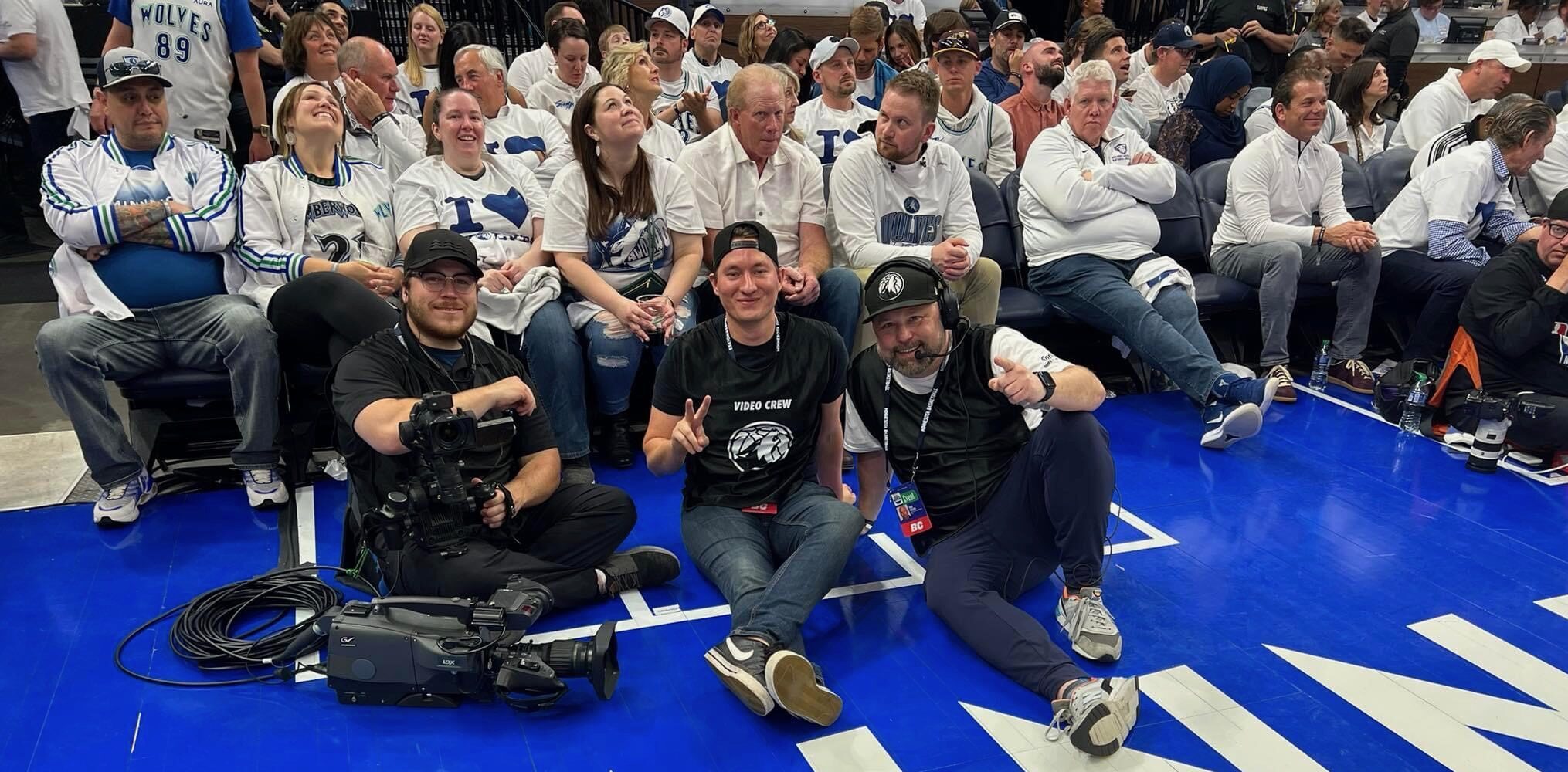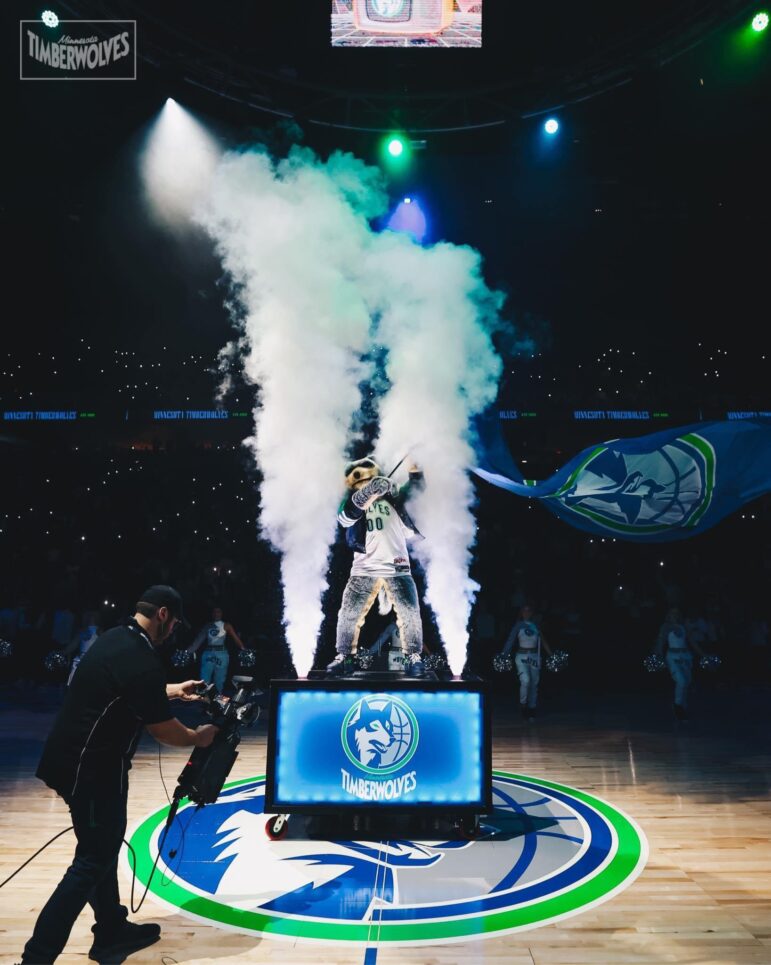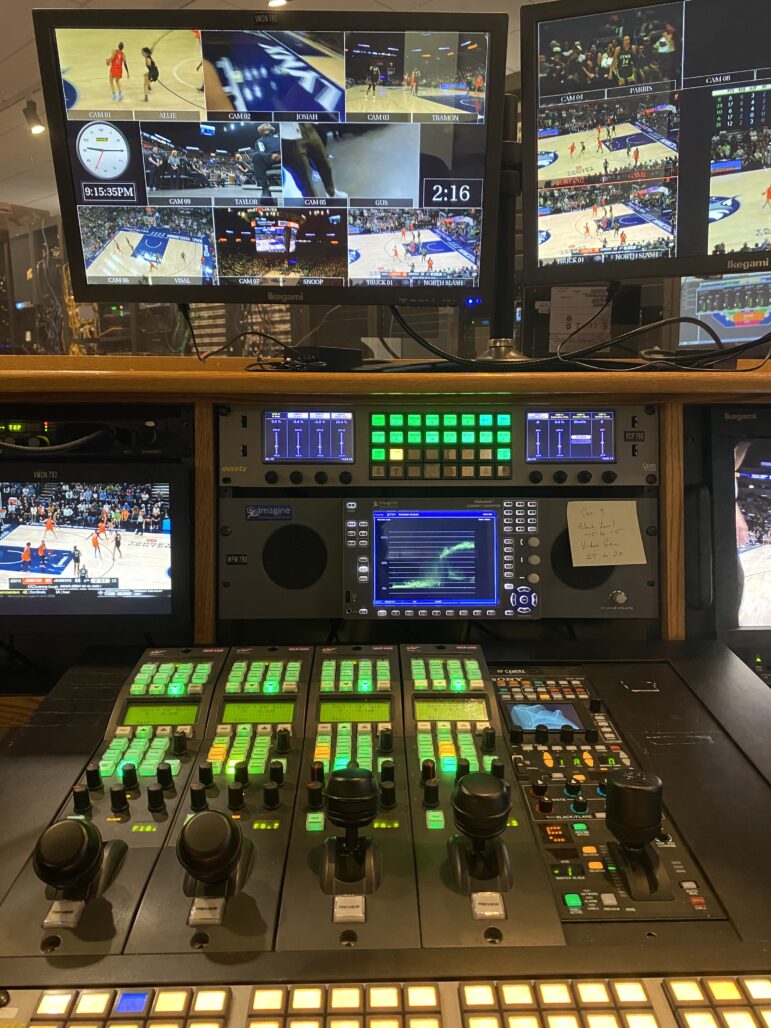
Workers from the Minnesota Timberwolves and Lynx in-house audio visual crew pose for a photo court side.

Share
While the highlight of attending a Minnesota Timberwolves or Lynx game may be to see Anthony Edwards or Napheesa Collier, the fan experience is a massive endeavor, made possible by everyday workers—who keep the venue clean, cook and serve snacks, and help direct crowds. And it’s the audio-visual crew that keeps fans cheering engaged, and ultimately, builds the crowd’s energy that the athletes can feed off of, in hopes that our favorite teams are victorious.
Now, some of those workers are hoping for a different kind of victory. In October, the in-house audio and video crew for the Minnesota Timberwolves and Minnesota Lynx at the Target Center filed for union representation with International Alliance of Theatrical Stage Employees (IATSE) Local 745. The union says the in-house crew asked for voluntary recognition from the teams’’ management, but after they didn’t receive an answer, they filed for a National Labor Relations Board election, and workers are set to vote through December 9. If successful, they would be the second unionized shop of in-house video and audio operators in Minnesota professional sports, after the Minnesota United FC Union, also represented by IATSE 745, formed in 2022.
Workers filed for the union in hopes for improved pay, healthcare benefits, and retirement contributions. They want to make the job more into a more stable, family-supporting career, they say. The Timberwolves and Lynx audio and video crew includes courtside camera operators who shoot the instant replays and fan cams, support with managing complex webs of chords and tripping hazards, screen promotions for the teams’ sponsors and giveaways, manage sound technology, and much more.
The story of the Timberwolves and Lynx audiovisual crew organizing didn’t begin with this latest union drive. In an interview with Workday Magazine, Charlie Cushing, a part-time business representative for IATSE and a full-time broadcast audio technician for other companies, says this crew of workers was misclassified as independent contractors for decades.
Misclassification, sometimes referred to as payroll fraud, occurs when companies misidentify workers as independent contractors, even though they act as employees of the company, often in order for the employer to avoid paying the worker benefits, overtime, and insurance. According to a recent report, an estimated 10% of private sector workers were misclassified in Minnesota in 2019.

Patrick Frost
An in-house audio visual camera operator on the job at a Minnesota Timberwolves home game at the Target Center in Minneapolis.In February 2016, the workers attempted to form a union. Cushing, one of the organizers at the time, states that about “90% of workers had signed their [union support] cards” at the beginning of the organizing drive. However, their classification status had to be decided first by the Region 18 National Labor Relations Board (NLRB) in Minneapolis, where the agency decided in the employer’s favor.
The decision was then appealed and brought before the NLRB in Washington, D.C., where the workers successfully overturned the previous decision and solidified their status as employees in August 2017. That gave them the right to form a union. However, their effort to form one was thwarted, Cushing says, which he attributes to the employer’s anti-union campaign, which he says included “getting rid of” pro-union workers.
Due to a lack of meaningful enforcement, the teams’ management continued to misclassify workers until 2022, according to Cushing and Josiah Wollan, a camera operator for the Minnesota Timberwolves and Lynx.
In the seven years since the first attempt at unionization, workers say they have seen little change in pay, benefits, and other demands. Cushing alleges that the workers have seen just three pay increases since 1989, and he believes that raises were largely used to undermine pro-union sentiment. Not only were workers making “embarrassingly low wages,” Cushing says that the workers also “weren’t getting parking reimbursement, weren’t paid for food, spending hundreds of dollars just to eat and park at the job.”
When Workday Magazine asked for a response to the allegations in this piece, they sent a statement that said: “The Minnesota Timberwolves and Lynx respect the rights of our part-time arena broadcast technology employees to organize, but we appreciate the working relationship we have with our employees and would rather not have a third party involved. The Timberwolves and Lynx offer competitive wages, benefits, and working conditions.”
The statement continues, “As recently as October 1, 2024, we implemented a wage increase for arena broadcast technology employees, which preceded any knowledge of an effort by IATSE to unionize this group. We will continue to support our arena broadcast technology employees and will respect any decision and outcome of a vote about unionization.”
But Cushing says,“They can certainly claim [the raise] wasn’t due to organizing activity, but I don’t think the facts support that. Because the only time this team ever gives out raises is when there’s organizing activity. This happened in 2016, 2022, and 2024.”
The audiovisual industry is made up of a lot of part-time and gig work—with many workers stringing together AV work at other venues, photography and videography side businesses, one-off audiovisual work for events, and other part-time and full-time work. Some even work a full-day at another job before working a night game.
One of the video operators and an organizer for the union drive, Wollan, described the audiovisual industry in an interview with Workday Magazine as both taking advantage of young people trying to break into the industry, and exploitative of retirement age workers who don’t have enough savings to retire.
“I’m a big Timberwolves fan. I would probably have worked for free in the beginning,” Wollan explains. “It was awesome to be so close to the action and I think the management took advantage of that.” On the other hand, he says, older workers are working through repetitive stress injuries because they cannot afford to retire.
Wollan describes the risk of “ginormous” athletes running full-speed into workers as they shoot the game from court side, and the bodily strain of carrying cameras, some of which are 300 pounds. This makes the lack of retirement contributions and healthcare that much more necessary, he argues.

Timberwolves weekend home game tickets can start anywhere from the low end of about $100, in the back of the arena, to thousands of dollars per ticket for courtside seats. According to one Forbes estimate, the Minnesota Timberwolves are valued at $3.1 billion dollars. The Minnesota Lynx are estimated at $85 million dollars.
The teams’ management have responded by repeating similar tactics from 2016 to 2017 union drive, workers alleged. One email from management, to Workday Magazine, describes unions as “just another type of business” and urges workers to vote against the union. The email later states, “We believe that electing a union would actually take away employees’ individual voices and transfer them to the union.”
Wollan hopes that the Timberwolves and Lynx management could make the job better suited for long-term, stable employment. “This could be a place where workers can support their families, but also be around for their family too, or even think about having a family,” he says.
In the meantime, crewmembers continue working to support Minnesota’s beloved teams. Wollan underscores, “We keep the fans in the game by showing all the great plays again, in different angles, and showing the missed calls that get the fans worked up. Oftentimes, we’re just relied on to hype up the crowd. In that way, we help out the teams too.”

